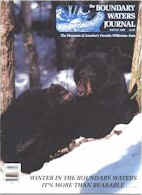

Sidebar to "An Early Winter Journey"
FROM THE BOUNDARY WATERS JOURNAL / WINTER 1989
By Mark Sakry
Be prepared for a thin-ice/immersion crisis. Following are some precautions and procedures that winter trekkers in northern lake country should remember:
1) Avoid these areas:
2) Wear skis or snowshoes to better distribute your weight.
3) Keep moving over suspicious ice. (Members of the Steger-Schurke expedition were able to cross one-inch sea ice, although reportedly more resilient than fresh-water ice, with thousand-pound sled loads by keeping a brisk forward motion).
4) Use quick-release equipment—ski bindings, harnesses, rope knots, etc.
5) Use an ice fishing auger, not a chisel, if you must test ice thickness; drill rapidly for a clean, unstressed cut.
6) Keep a loose coil of rope handy in your parka pocket to throw to rescuers (or victim).
7) Carry a vacuum bottle of hot fruit drink and a good sleeping bag wrapped in waterproof plastic to treat immersion victims for hypothermia—even on day trips. (A spare set of warm clothes is also recommended).
8) For self-rescue: DO NOT PANIC. It's awfully cold, but you must keep your head and get out of the water as quickly as possible. Try to hook an arm and a leg onto the ice and roll out sideways as best you can. Distribute your weight. If you can manage it, use the tips of your ski poles for ice picks and pull yourself out. Then scramble spread-eagle fashion across the ice away from danger. Change immediately into warm clothes, build a fire, and seek the most available help. Drink hot liquids and eat high-energy trail food. Insulate with a dry sleeping bag or change of warm clothes. Hop around, if you're able, to generate body heat and promote blood circulation.9) To ASSIST rescue: Use any means of extension available to pull victim from water, without risk to you or any companions. Use rope, pack sled, ski or ski pole—whatever you can safely extend without breaking through the ice yourself. (Human chains, such as gripping ankles while laying flat on the ice, should only be considered as a last resort). Rescue should be performed without panic and without delay. Treatment for hypothermia should be administered immediately, whether the victim feels it is necessary or not. Proceed ONLY when you are confident the victim is stable (overnight preferred).
10) Become well-versed in ground-to-air emergency codes and aircraft acknowledgement signals—or carry cards which describe them. The ones you should know are:
V — Require Assistance
X — Require medical assistance
Arrow — Proceeding in this direction
THE BOUNDARY WATERS JOURNAL / WINTER 1989LL — All's well
MAIN ARTICLE:
An Early Winter Journey
RELATED TOPICS:
The Quin-Zhee Shelter
Snowcamp: Romancing Winter in the Lake Superior Wilderness
Handling Medical Emergencies in Canoe Country
Get Ready to Camp in Winter
Cold-Weather Deer Quiz